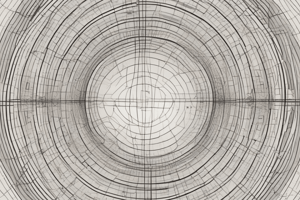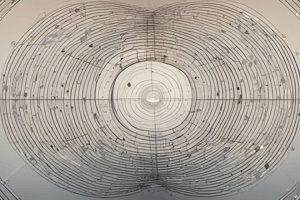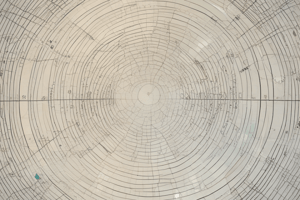Podcast
Questions and Answers
Which formula can be used to calculate the circumference of a circle?
Which formula can be used to calculate the circumference of a circle?
- C = 2πr^2
- C = 2πr (correct)
- C = π(r/2)
- C = πr^2
What is the relationship between the center and any point on a circle?
What is the relationship between the center and any point on a circle?
- They are always at different distances
- It depends on the size of the circle
- They are equidistant (correct)
- The center is always closer to the edge of the circle
What is the area of a circle with radius 5 units?
What is the area of a circle with radius 5 units?
- \(10π ext{ sq units} ext)
- \(20π ext{ sq units} ext)
- \(5π ext{ sq units} ext)
- \(25π ext{ sq units} ext) (correct)
What type of symmetry is exhibited when we reflect a circle along its diameter?
What type of symmetry is exhibited when we reflect a circle along its diameter?
What happens to a cyclic quadrilateral formed by two circles sharing tangents?
What happens to a cyclic quadrilateral formed by two circles sharing tangents?
What property do circles with rotational symmetry exhibit when turned around their centers?
What property do circles with rotational symmetry exhibit when turned around their centers?
What type of pattern emerges when circles are packed together randomly?
What type of pattern emerges when circles are packed together randomly?
How does packing circles in a hexagonal grid impact storage space usage?
How does packing circles in a hexagonal grid impact storage space usage?
Which aspect of circles helps reinforce understanding of coordinate systems and transformations?
Which aspect of circles helps reinforce understanding of coordinate systems and transformations?
What mathematical concept does learning about circles lay a fundamental foundation for?
What mathematical concept does learning about circles lay a fundamental foundation for?
In analytical geometry, what does relating circles help us do with problems?
In analytical geometry, what does relating circles help us do with problems?
Flashcards are hidden until you start studying
Study Notes
Exploring Math through Circular Shapes
Circles have been captivating mathematicians' minds since ancient times due to their simplicity yet intricate properties. This exploration into circles will unveil some of their fascinating features, touching upon geometry, algebra, and analysis—all within the realm of math.
A circle is defined by its center point (O) and radius (r), forming a two-dimensional shape with every point equidistant from the center ((d = r)). Each circle also has a unique circumference given by the formula (C=2πr), which can help us calculate the perimeter of any circular object.
One essential aspect of circles is their area, denoted as (\pi r^2). We recognize this constant value as Pi. Studying the properties of Pi, such as approximations and decimal expansions, provides insight into number theory while exploring equations like the Pythagorean theorem involving circles.
The intersection points between two circles, coined tangent points, reveal much about their relationship. For example, if two non-intersecting circles share tangents, they form a cyclic quadrilateral whose interior angles sum up to 360 degrees.
Circle symmetry plays a vital role in various aspects of mathematics. One type of symmetry called rotational symmetry arises when we turn the circle around its center by certain multiples of an angle, resulting in identical images. Another form of symmetry occurs along diameters of the circle; it is known as reflectional symmetry. These symmetries enable us to analyze figures more easily.
In addition to studying individual circles, mathematicians often explore collections of them. For instance, Packing circles together to create a hexagonal grid enables efficient storage space usage. On the other hand, packing circles randomly results in fractals, where self-similar patterns appear repeatedly.
Furthermore, relating circles back to analytical geometry allows us to represent, visualize, and solve problems using coordinates. Understanding the relationships among radii, diameter, chord, arc length, sector areas, etc., helps reinforce our understanding of coordinate systems, functions, and transformations.
From elementary school to advanced university courses, learning about circles lays a fundamental foundation for many mathematical concepts. Analyzing the intricate geometry and applying abstract theories make circles both intriguing and integral to mathematical studies.
Studying That Suits You
Use AI to generate personalized quizzes and flashcards to suit your learning preferences.




